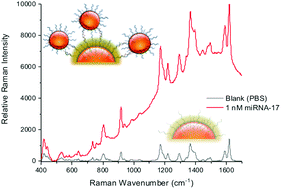A SERS approach for rapid detection of microRNA-17 in the picomolar range†
Abstract
Epigenetic biomarkers are powerful tools for early disease detection and are particularly useful for elusive conditions like preeclampsia. Predicting preeclampsia at an early stage is one of the most important goals of maternal–fetal medicine. To this end, recent studies have identified microRNAs—such as microRNA-17—as early biomarkers for preeclampsia. Yet clinical applications are lagging, owing in part to the sensing challenges presented by the biomarkers’ small size and complex environment. Surface enhanced Raman spectroscopy (SERS) is an emergent optical technique that is recognized for its potential to overcome these challenges. In this study, DNA functionalized nanoparticles were designed as probes to capture and quantify miRNA-17 in solution. SERS was used to determine the presence and concentration of miRNA-17 based on the formation of plasmonic nanoparticle aggregates. The miRNA-17 assay was tested at concentrations of 1 pM to 1 nM in both PBS and a representative complex biological sample. In both situations the assay was unaffected by non-complementary microRNA samples. These results demonstrate SERS's specificity and sensitivity for a new biomarker (miRNA-17) that may ultimately be used in a detection platform for early diagnosis of preeclampsia.



 Please wait while we load your content...
Please wait while we load your content...
